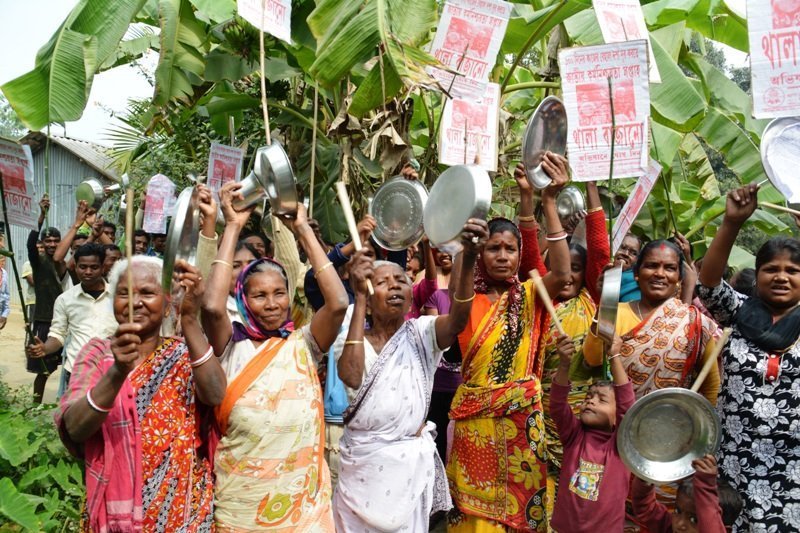Posted by Srilata Sircar
On the occasion of two years having gone by since the fateful announcement of ‘demonetisation’ was made, the finance minister Arun Jaitley addressed the media and the nation. The aim of this address was apparently to justify yet again, why this policy measure was introduced and to simultaneously proclaim its unqualified success. One would think that successful policy measures are self-justifying, but so be it.
In his address the FM repeated several claims that have previously been in circulation on social media and opinion pieces from right-leaning and BJP-allied public voices. As many have been pointing out for two years now, the logic behind demonetisation has constantly shifted pretty much from the moment of its implementation. From black money to curbing terror to cashless economy, the buck has changed many hands. It now seems to have stopped with ‘formalisation’. Again, many have pointed out that this term did not enter the political discourse around demonetisation until much after the policy was announced.
Nonetheless, the FM and his social media interlocutors make two main claims in support of this idea of formalisation. The first is that of an expanded tax base and the second is that of increased digital transactions. Both have been promptly disputed, and dare I say – disproved. But going beyond the bickering over data, I propose that we focus for a moment on the rhetoric mobilised by the FM in his use of this word and the ideas it denotes. What might we learn from a feminist perspective by pausing and thinking about this term?
Also read: How Is Demonetisation Affecting The Disabled?
When the terms ‘formal’ and ‘informal’ are thrown around in public political discourse by powerful actors, they seldom come with a definition or an elaboration. The public is expected to intuitively know what these terms denote. For the most part in the urban-elite popular imagination the term ‘informal’ conjures up images of shady, unwieldy parts of our lifeworlds – ‘slums’, below-the-table transactions, extractive middle-men and the like. It is exactly this imagination that the FM appeals to repeatedly by talking about formalisation in the context of tax-payers, thereby rendering the informal as ‘evaders’, ‘defaulters’, and hence lesser citizens.
many have pointed out that the term ‘formalisation’ did not enter the political discourse around demonetisation until much after the policy was announced.
In his address the FM makes no reference whatsoever to employment, livelihoods, or labour relations. Ironically, it was in connection to these particular issues that the term ‘informality’ first came into circulation within academic and policy discourse. In course of time it has come to represent all social and economic phenomenon that are outside of the regulatory structures of the state.
The reasons for this exclusion are wide-ranging and I will come to some of them in a bit. But the very first thing to flag here is that there are no standardised definitions of formality or informality in the Indian context. The Economic Survey of 2018 and the National Sample Survey of 2011-12 defined formality variously for enterprises and for individual workers based on number of employees, use of power sources, inclusion in the GST net, presence of a written contract, access to social security and other factors.
The terminology used prior to that was of ‘organised’ and the ‘unorganised’ sectors of the economy. One of the constants through these shifting definitions has been the fact that the entire agricultural sector is by default considered to be ‘informal’ or ‘unorganised’.
This is where a feminist lens on demonetisation becomes particularly useful. Despite its falling share in GDP, agriculture still accounts for more than 50% of employment in India. Due to rising rural-to-urban migration among male workers, there has also been a strong trend of feminisation of agricultural labour.
As of 2011 there were close to 100 million women working in agriculture, representing one-fourth of the total workforce in India. None of these women would qualify as formal tax payers as per the FM address. This is not because these women are unwilling to file and disclose their incomes. It is because agricultural incomes by law are non-taxable. Moreover these incomes are earned in the form of cash wages payed out daily, weekly, or seasonally. The wage rates differ not only from region to region but sometimes even from village to village.
Needless to add, the work conditions of these women farmers are not secured through any labour rights laws, laws against sexual harassment at the workplace, or laws providing security of tenure. The same holds true for men employed as wage labourers in agriculture and both men and women employed in construction work. These are the people who were worst hit by demonetisation. Those whose day-to-day subsistence is dependent on cash wages. And yet none of these workers are tax-evaders or defaulters as the FM would have us believe.
Informality in India exists in collusion with formal structures. In fact, the continued existence of informality is what keeps the formal structures functioning. Allow me to demonstrate this with a few examples. The most glaring and pervasive case where informality is sanctioned by formal structures is that of sanitation work. Manual scavenging has been banned in India since 1993 and yet every municipal body in the country continues to employ workers to manually clean sewer and septic tanks.
These workers are routinely deprived of essential safety gear and are employed through complex networks of contractors and sub-contractors that shifts responsibility away from the formal organisations. The same modus-operandi is followed in the case of construction work. The formal sector organisation (both public and private) that undertake the construction project then outsource the actual physical labour through a network of contractors and sub-contractors, to daily-wage workers who have no legal, physical, or financial security. In the recently launched 100 Smart Cities Mission the formal structures have outdone themselves in circumventing their own formality.
there were close to 100 million women working in agriculture, none of them would qualify as formal tax-payers as per the FM address.
By creating something called ‘Special Purpose Vehicles’ that are private bodies meant to implement the smart cities interventions, the state has done away with all sense of democratic accountability. As non-elected private organisations, the SPVs are answerable to none other than a few select bureaucrats who are invested in the success of the SPV and the mission to begin with. Thus even though people employed in these SPVs will be perfectly tax-paying and formal citizens, their work will remain beyond the purview of regulation by democratically elected urban representatives. Informality thus is structurally institutionalised in India.
Despite existing in such varied and vivid forms at different levels of socio-economic life, informality is easily perceived as a legitimate collateral damage for the higher goals of ‘digitisation’, ‘modernisation’ and such. This is the reason why when faced with the news of starvation deaths, our politicians as well as members of our public are able to look away and point instead at rising digital transactions. As if the gains on the scale of modernity can not only morally outweigh the loss of lives but also that those particular lives were worthy of being sacrificed.
I argue that this mode of thinking is deeply rooted in a masculinist, hetero-patriarchal logic. Think for instance of the longstanding logic of patriarchy that women should and must sacrifice their minds and bodies, their health and leisure, for the sustenance of the family and the nation. A good woman is one who self-destructs and a good informality is one that self-disappears.
This connection to patriarchal values is further exemplified in the constant rhetoric of ‘data’. Even though most statistical data, however tenuously put together, has already pointed towards the utter failure of demonetisation, some of its supporters (Surjit Bhalla is prominent among them) continue to demand that critics produce ‘empirical evidence’ of the devastation wrought by this policy. Most often they point to indicators such as growth rates, ‘ease of doing business’ indices, and growth in mutual fund investments as ‘empirical evidence’.
A good woman is one who self-destructs and a good informality is one that self-disappears.
This obsession with large aggregated numbers, however spuriously calculated, is also a legacy of the dominant hyper-masculinist way of doing science. The whole idea behind aggregates is to do away with nuance and underlying differences. The process behind the calculation of such aggregates is more often than not, mired in multiple layers of approximations, estimations, and assumptions that completely erase the actual lived reality of the phenomenon they seek to represent. This is the reason why feminist approaches within various fields of study have sought to shift focus onto qualitative and immersive modes of doing research that centre the actual affective experiences of people in the world.
For instance Meera Sanyal has spoken about how she started the research for her book on demonetisation by asking people what they were doing when the announcement of the policy took place. The startlingly detailed responses that people gave, bore testimony to how far-reaching the impact of the decision had been on their lives. Similarly, there have been many detailed narratives of suffering and struggle resulting from demonetisation that have been in the public domain from day one. But somehow none of these are given the sanctity of ‘empirical evidence’.
In course of building my own identity as a feminist geographer, I have sought lessons and inspiration from multiple sources. One of the lessons that I have abided by is something that came from the acclaimed feminist filmmaker Paromita Vohra. While defining feminism during an interview, Vohra said that feminism is the act of bringing a loving eye to that which has not been seen with a loving eye before. I propose that we learn to see the informal with a loving eye.
Instead of assuming that the informal is inherently corrupt, evasive, and a burden on the path to modernity if we bring a loving eye to it we might see something different. We might see that the informal is not just a greenfield of unharvested taxes, but that it is also where our food is grown and our houses are built and our drains are cleaned.
Also read: Demonetisation, Drama And The Debacle: Decoding Our ‘Larger Good’
We might even be able to see that ‘informal’ is just a stigmatising tag that we place on people and places when we are unable to look at them with feminist love. When we finally see this, we might also begin to notice the sheer devastation that a move like demonetisation can wreak on it. This might lead us to that other visceral emotion that lies at the root of all feminist labour – rage. For rage is what we must feel when we learn how the world has wronged those that we love.
Srilata Sircar is a feminist geographer based at King’s College London.
Featured Image Source: Asia News
About the author(s)
Guest Writers are writers who occasionally write on FII.




